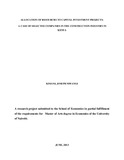| dc.description.abstract | Building and Construction industry enhances economic growth in the economy through interlinkages
that spur investment. The sector contributed less than 5% to the GDP every year.
Failure to complete an investment project on time means that a given investor would be caught
up by the cost push inflation since the overall cost of material and labour indices in building and
construction industry tend to rise with time. When many projects are not completed in the
budgeted period, then the whole economy is affected negatively in terms of development. In
order to unlock the full potential in the construction industry, there was need for an effective
mechanism in which the resources are allocated in the construction industry. This study
investigated how the resources in a construction project can be allocated through the Critical
Path model guided by the marginal cost criteria in employing extra resources to a project in order
to complete it on time or earlier than scheduled. To carry out the study, a random sample of
thirty (30) Companies was picked from a population of three hundred (300) construction
companies located in Nairobi County which had been registered with the Ministry of Public
Works. The data for the survey was collected through questionnaires which were sent to the
random sample of thirty construction companies located in Nairobi County. The questionnaires
were presented to Project Managers of the companies selected and they were requested to fill
them in within a week. From the questionnaires returned by the respondents, data on activity
duration, normal time, normal cost, crash time, crash costs, frequency of project failure in terms
of project completion time and cost overruns, criterion of employment of extra resources and
estimation of likelihood of completing a project on a scheduled date was obtained. The data was
tabulated and industrial expected times and costs were calculated. The network diagram was
drawn and five critical activities A, C, E, G and I were obtained. The marginal cost of critical
activities were calculated and arranged in ascending order. The critical activities were crashed in
the order of marginal cost rankings starting with the activity with the lowest marginal cost. Total
project cost showed that each and every time critical activity was reduced by a day as result of
employment of more factors of production, the total cost was falling. A total project cost curve
was plotted on a graph of cost against time and a turning point of the curve indicated the optimal
point. At the optimal point, the project completion time and cost were obtained. The likelihood
of completing the project within the optimal point was ascertained and found to be 0.9987. This
represented almost a 100% chance of completing a project on time. Since the model could
ascertain the likelihood of completing an investment project on time in order to avoid budgetary
overruns in the construction industry. It was concluded that the critical path model through the
marginal cost criteria was effective in allocating resources in a construction industry. | en |

